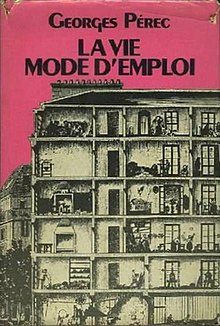Life a User's Manual

Cover of English translation
|
|
| Author | Georges Perec |
|---|---|
| Original title | La Vie mode d'emploi |
| Translator | David Bellos |
| Country | France |
| Language | French |
| Publisher | Hachette Littératures |
|
Publication date
|
1978 |
|
Published in English
|
1987 |
| ISBN | (1978 paperback, first English translation) (1987 hardcover) (2008 paperback, revised translation) |
Life a User's Manual (the original title is La Vie mode d'emploi) is Georges Perec's most famous novel, published in 1978, first translated into English by David Bellos in 1987. Its title page describes it as "novels", in the plural, the reasons for which become apparent on reading. Some critics have cited the work as an example of postmodern fiction, though Perec himself preferred to avoid labels and his only long term affiliation with any movement was with the Oulipo or OUvroir de LIttérature POtentielle.
La Vie mode d'emploi is a tapestry of interwoven stories and ideas as well as literary and historical allusions, based on the lives of the inhabitants of a fictitious Parisian apartment block, 11 Rue Simon-Crubellier (no such street exists, although the quadrangle Perec claims Simon-Crubellier cuts through does exist in Paris XVII arrondissement). It was written according to a complex plan of writing constraints, and is primarily constructed from several elements, each adding a layer of complexity.
Between World War I and II, a tremendously wealthy Englishman, Bartlebooth (whose name combines two literary characters, Herman Melville's Bartleby and Valery Larbaud's Barnabooth), devises a plan that will both occupy the remainder of his life and spend his entire fortune. First, he spends 10 years learning to paint watercolors under the tutelage of Valène, who also becomes a resident of 11 Rue Simon-Crubellier. Then, he embarks on a 20-year trip around the world with his loyal servant Smautf (also a resident of 11 rue Simon-Crubellier), painting a watercolor of a different port roughly every two weeks for a total of 500 watercolors.
Bartlebooth then sends each painting back to France, where the paper is glued to a support board, and a carefully selected craftsman named Gaspard Winckler (also a resident of 11 rue Simon-Crubellier) cuts it into a jigsaw puzzle. Upon his return, Bartlebooth spends his time solving each jigsaw, re-creating the scene.
Each finished puzzle is treated to re-bind the paper with a special solution invented by Georges Morellet, another resident of 11 rue Simon-Crubellier. After the solution is applied, the wooden support is removed, and the painting is sent to the port where it was painted. Exactly 20 years to the day after it was painted, the painting is placed in a detergent solution until the colors dissolve, and the paper, blank except for the faint marks where it was cut and re-joined, is returned to Bartlebooth.
...
Wikipedia
